Identification and validation of up-regulated TNFAIP6 in osteoarthritis with type 2 diabetes mellitus
- PMID: 39733138
- PMCID: PMC11682049
- DOI: 10.1038/s41598-024-82985-5
Identification and validation of up-regulated TNFAIP6 in osteoarthritis with type 2 diabetes mellitus
Abstract
Lines of evidence have indicated that type 2 diabetes mellitus (T2DM) is an independent risk factor for osteoarthritis (OA) progression. However, the study focused on the relationship between T2DM and OA at the transcriptional level remains empty. We downloaded OA- and T2DM-related bulk RNA-sequencing and single-cell RNA sequencing data from the Gene Expression Omnibus (GEO) dataset. Differential expression analysis and weighted gene co-expression network analysis (WGCNA) were performed to screen out hub genes between OA and T2DM, and functional enrichment was done. Single-cell sequencing analysis was further used to screen key genes on OA and T2DM datasets. Rat chondrocytes and human articular cartilage were used to validate biomarkers among OA and T2DM. Sixty-eight hub genes were obtained, which were mainly enriched in the inflammatory response. We found that the hub gene TNFAIP6 is not only closely related to OA and T2DM but also a marker of prehypertrophic chondrocytes, which are closely related to the progression of OA. TNFAIP6 was found to be significantly elevated in CD14 + monocytes in T2DM patients, and this group of cells can promote inflammation. Validation on rat chondrocytes and human cartilage showed that TNFAIP6 was highly expressed in OA and further increased in the presence of T2DM or high glucose. Our study identified several characteristic modules and hub genes in the pathogenesis of T2DM-induced OA, which may facilitate further investigation of its molecular mechanisms. Up-regulated TNFAIP6 may contribute to OA in patients with T2DM by the recruitment of pro-inflammatory CD14 + monocytes in the OA synovium, which provides a potential target for the diagnosis and treatment of T2DM-associated OA.
Keywords: Bioinformatics; Osteoarthritis; Single-cell RNA sequencing; Type 2 diabetes mellitus; Weighted gene co-expression network analysis.
© 2024. The Author(s).
Conflict of interest statement
Declarations. Competing interests: The authors declare no competing interests. Ethics statement: All animal procedures were conducted according to the Guidelines for Care and Use of Laboratory Animals of the National Institutes of Health and approved by the Experimental Animal Welfare Ethics Committee, Zhongnan Hospital of Wuhan University (ZN2022191). The studies involving human specimens were reviewed and approved by the Medical Ethics Committee, Zhongnan Hospital of Wuhan University (2022151 K). The authors ensured that all participants were given the necessary information and signed informed consent forms before proceeding with the study.
Figures

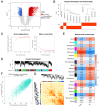
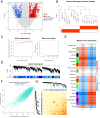
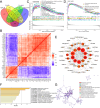
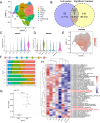
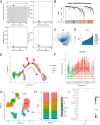
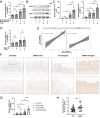
Similar articles
-
Identification of osteoarthritis-associated chondrocyte subpopulations and key gene-regulating drugs based on multi-omics analysis.Sci Rep. 2025 Apr 11;15(1):12448. doi: 10.1038/s41598-025-90694-w. Sci Rep. 2025. PMID: 40216809 Free PMC article.
-
Identification of key biomarkers related to fibrocartilage chondrocytes for osteoarthritis based on bulk, single-cell transcriptomic data.Front Immunol. 2024 Nov 21;15:1482361. doi: 10.3389/fimmu.2024.1482361. eCollection 2024. Front Immunol. 2024. PMID: 39640258 Free PMC article.
-
The Potential Dual Roles of Metallothionein-1/-2 in Diabetic Osteoarthritis.J Cell Physiol. 2025 Jun;240(6):e70056. doi: 10.1002/jcp.70056. J Cell Physiol. 2025. PMID: 40518852
-
Molecular regulation of articular chondrocyte function and its significance in osteoarthritis.Histol Histopathol. 2011 Mar;26(3):377-94. doi: 10.14670/HH-26.377. Histol Histopathol. 2011. PMID: 21210351 Review.
-
Age-related degeneration of articular cartilage in the pathogenesis of osteoarthritis: molecular markers of senescent chondrocytes.Histol Histopathol. 2015 Jan;30(1):1-12. doi: 10.14670/HH-30.1. Epub 2014 Jul 10. Histol Histopathol. 2015. PMID: 25010513 Review.
References
-
- David, J., Hunter, S. B. Z. & Osteoarthritis Lancet393, 1745–1759, doi:10.1016/S0140-6736(19)30417-9 (2019). - PubMed
-
- Visser, A. W. et al. The relative contribution of mechanical stress and systemic processes in different types of osteoarthritis: the NEO study. Ann. Rheum. Dis.74, 1842–1847. 10.1136/annrheumdis-2013-205012 (2015). - PubMed
Publication types
MeSH terms
Substances
Grants and funding
- PTXM2021033/Research fund from medical Sci-Tech innovation platform of Zhongnan Hospital, Wuhan University
- ZNQNJC2022001/Youth Interdisciplinary Special Fund of Zhongnan Hospital of Wuhan University
- 81972036, 81603214, 82002265/National Natural Science Foundation of China
- 2020BCA071/Key Research and Development Project of Hubei Province
LinkOut - more resources
Full Text Sources
Medical
Research Materials

